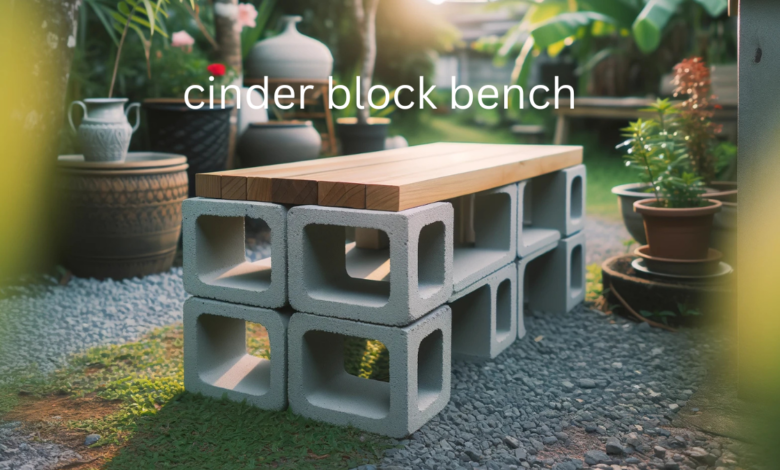Building Comfort: Crafting a Cinder Block Bench for Your Outdoor Space

Introduction
DIY projects offer a personal cinder block bench touch to home décor, and when it comes to outdoor spaces, creating furniture that withstands the elements is crucial. A cinder block bench is an excellent project for those looking to enhance their garden or patio with a durable, cost-effective, and stylish seating option. This guide will walk you through the process of building a bench using cinder blocks, a material celebrated for its strength and versatility. Not only is this project affordable, but it also allows for a high degree of customization to suit any outdoor setting.
Choosing the right materials for outdoor furniture can be daunting due to the exposure to weather and the need for longevity and aesthetics. Cinder blocks, typically used in construction for their structural qualities, make an ideal choice for outdoor furnishings due to their robustness and ease of use. By the end of this article, you will know everything needed to construct your own cinder block bench, from the necessary materials to step-by-step assembly instructions.
Why Choose Cinder Blocks?
Cinder blocks are a staple in the construction industry because of their structural integrity and resistance to weather conditions such as moisture and extreme temperatures. These blocks are not only sturdy but also incredibly cost-effective, often costing less than traditional wood or metal outdoor furniture. Additionally, the heavyweight of cinder blocks provides stability, making them perfect for creating outdoor seating that remains secure in varied weather conditions.
The simplicity of cinder blocks also allows for DIY projects that can be completed quickly and with minimal tools. Unlike wood, which can require extensive cutting and sanding, cinder blocks can be stacked and arranged in numerous configurations without any modification. Their modular nature enables you to design a bench that fits perfectly into your space, whether it’s a snug garden nook or a spacious patio area. The ease of assembly makes cinder blocks a go-to choice for DIY enthusiasts looking to add functional, rustic charm to their outdoor décor.
Materials Needed

To begin your cinder block bench project, you will need several straightforward materials. The primary component, cinder blocks, are readily available at any hardware store. You’ll typically need 12-18 blocks depending on the desired length and height of your bench. For the seating surface, lumber is the most common choice, with cedar or redwood offering both durability and a pleasing aesthetic. Ensure the wood is treated or suitable for outdoor use to prevent decay.
You will also need some basic tools, such as a paintbrush and sandpaper, if you decide to paint or stain the wood and blocks. For a more personalized touch, consider outdoor cushions for comfort and style. These not only add a layer of comfort but can also reflect your personal design style with various colors and patterns. Lastly, if you opt for additional functionality, such as built-in planters or storage areas, additional materials like construction adhesive or more specialized tools might be required.
Design Considerations
Before construction, planning is crucial. Consider the size and location of the bench. A common design includes a two-block height and three-block length cinder block bench, providing ample seating space without overpowering the garden or patio. When choosing a location, look for a level area that supports the weight and size of the bench. Ensure it complements the overall layout and aesthetic of your outdoor space.
Safety is paramount, especially when working with heavy materials like cinder blocks. Ensure the area is stable and safe for seating, and consider securing the blocks with mortar or adhesive if there are concerns about the bench shifting. Additionally, think about the overall design and how it will fit into your garden or patio. For a cohesive look, consider the color scheme and texture of your existing outdoor decor. Adding a sealant to both the wood and the blocks can enhance durability and maintain the appearance of your bench over time.
Step-by-Step Building Guide
Preparation
Start by preparing your workspace, clearing any debris, and ensuring a flat surface. Gather all materials and tools before beginning to streamline the construction process.
Construction
Step 1: Arrange the cinder blocks in the desired location in a rectangular formation to form the base. Ensure each block is level and aligned. Step 2: Stack the second layer of blocks, alternating the direction to create a more stable and interlocked structure. Step 3: If desired, apply a strong adhesive between the layers to secure the structure. Step 4: Measure and cut the lumber to fit across the cinder blocks, then place the wooden slats evenly across the top, securing them if necessary.
Finishing Touches
Paint or stain the cinder blocks and wood as desired. Attach cushions and add any decorative items such as outdoor pillows or side tables to enhance the functionality and aesthetic appeal of your bench.
Conclusion
Building a cinder block bench is an enriching project that not only adds functional outdoor seating but also enhances the visual appeal of your space. With the right materials, a bit of creativity, and this guide, you can create a durable and attractive addition to your outdoor living area. Remember to personalize your bench with paint, cushions, and other décor to make it truly yours.
FAQs
How long does it take to build a cinder block bench?
Typically, it can take a few hours to assemble the bench, depending on the complexity of the design and preparation of materials.
What is the best type of wood to use for the seating area?
Cedar or redwood are excellent choices due to their durability and resistance to decay, making them ideal for outdoor use.
How can I make the cinder block bench more comfortable?
Add outdoor cushions and throw pillows for extra comfort and style.
Can the cinder block bench be moved once it is assembled?
While cinder block benches are heavy, they can be moved with assistance. If you anticipate needing to move the bench often, consider a lighter design or adding wheels.
What are the best weatherproofing practices for a cinder block bench?
Sealing the wood and cinder blocks with a waterproof sealant can protect against weather damage and extend the life of your bench.
You May Also Read :https://workuptime.co.uk/noron/

